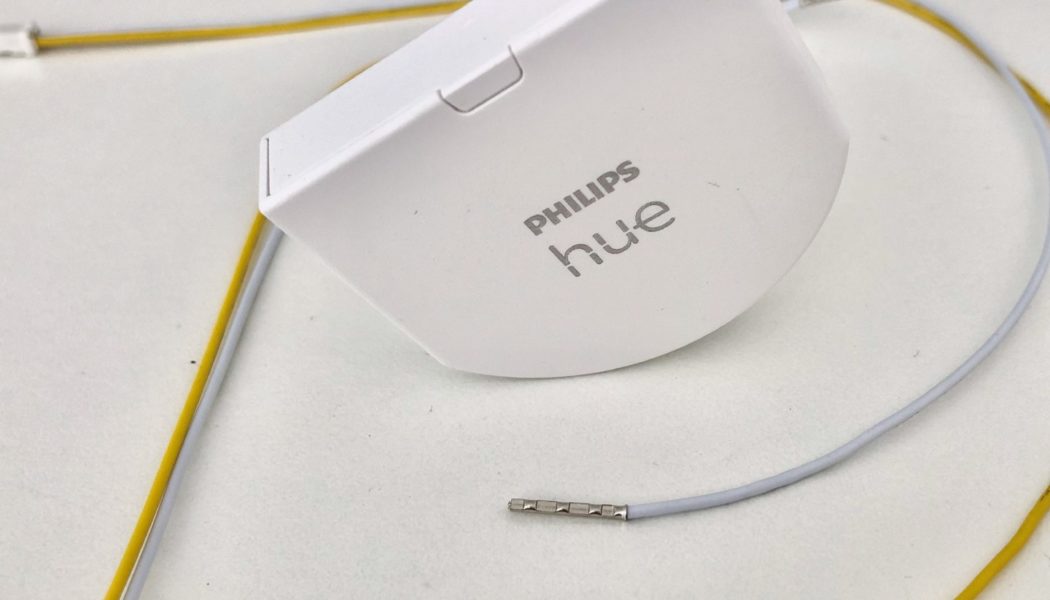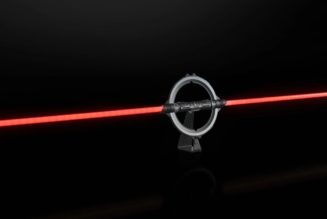You’ve undoubtedly run across taped light switches like the one pictured above if you’ve ever spent time in Airbnbs. Hell, maybe you have some of these in your own smart home. No judgement, we’ve all been there, which is why I just installed a Philips Hue Wall Switch Module in my own house.
Many smart home fans can trace their obsession back to the very first Hue lightbulbs launched back in 2012 as an Apple Store exclusive. But Hue bulbs, like all smart bulbs, come with a few catches. First, they require a constant source of power to function. That means you’ll lose control over that fancy Hue bulb hanging above your kitchen table just as soon as someone flicks off the light switch. To solve this, many people disable the switch mechanism with tape or a dummy wall plate, only to realize that physical controls are useful when you or your housemates and guests can’t be bothered to yell a command or pull out a phone. So they buy a Hue remote control and tape it to the wall. This comedy of errors is then repeated over and over until they have a house full of mismatched wall switches and legitimate concerns about life priorities.
There’s a small cottage industry of aftermarket solutions for this, including Lutron’s Aurora dimmer that sits on top of a light switch. But Philips has never addressed it directly, until now. The new $39.95 Hue Wall Switch Module solves these issues by making most existing wall switches Hue-smart.
Note that I said Hue-smart, not smart. That’s because the switch you rewire to the Hue Module can only control Hue lightbulbs, not regular inexpensive lights like other smart switches. Nevertheless, it caters to fans of both smart lights and smart switches by offering the benefits of both, so long as they can stomach the cost and ecosystem lock-in.
The Wall Switch Module from Signify-owned Philips Hue is a much simpler device than it first appears. Basically, it’s a buttonless Zigbee remote control for Hue lights. You add buttons by wiring the Hue Module to a standard household light switch. The switch + Hue Module works as a Hue remote control whether tucked inside the wall or not since the Hue Module is powered by a single CR2450 coin battery (included). That allows you to make sure the Hue Module and switch are working properly with your Hue setup before connecting everything back to the wall. It also means that you’ll have to have to disassemble everything at some point in the future to replace the battery, but not for at least five years, according to Philips Hue.

I was able to install a Philips Wall Hue Switch Module behind the existing switch in my laundry room in about fifteen minutes. The steps were quite simple, but you’ll need enough empty space in the wiring box behind the switch to accommodate the 4.3 x 1.0 x 3.8 cm (0.51 x 0.39 x 1.5 inch) Hue Switch Module. You should also be comfortable working with household electricity — if not then find someone who is or call an electrician.
:no_upscale()/cdn.vox-cdn.com/uploads/chorus_asset/file/22530170/verge_IMG_7358_2040pxl.jpg)
:no_upscale()/cdn.vox-cdn.com/uploads/chorus_asset/file/22530198/verge_IMG_7214__1__2040pxl.jpg)
Installation is straightforward with the help of videos tutorials supplied by Philips Hue. After shutting off the power at my circuit breaker, I removed the switch assembly from the wall. I then disconnected the two electrical wires connected to my rocker switch and rerouted them into a tiny Hue-supplied wire connector to close the circuit and ensure my lightbulb socket is never without power. I then plugged a Hue-provided wire-pair into the Hue Module and back to the light switch at the same locations where the two household wires were removed.
The Hue Switch Module is added to the Hue app and Hue Bridge (required) like any Hue light or accessory. After assigning the Module to control the Hue bulb in my laundry room, all that was left was to tuck the Hue Switch Module into the wall box and remount the switch.
The Hue Module can be assigned to control multiple Hue lights in a Hue-defined room or zone, or just one Hue bulb in my case. The switch can be set to function as a simple on/off, or to cycle through predefined Hue scenes assigned to one, two, or three presses.
:no_upscale()/cdn.vox-cdn.com/uploads/chorus_asset/file/22530188/Hue_app_scenese.jpeg)
Scenes didn’t work too well on my rocker switch since a “press” is only registered after both an on / off motion, meaning I’d have to toggle the switch up, down, up, down, up to toggle the scene assigned to the third press. And since my laundry room doesn’t require mood lighting anyway I went with the simple on / off toggle.
The Philips Hue Wall Switch Module solves the issue of someone flipping the light switch and rendering the smart bulb useless. Although it does occasionally miss a beat causing the switch to reverse orientation. Over the weeks I’ve had it installed, I noticed that flipping the switch up turns the light on some days and off on others. That means the module failed to trigger the light somewhere along the way despite it being installed smack in the middle of my relatively small house which is blanketed in a strong Zigbee signal created by ten other Hue lights and plug-in accessories.
To test the failure rate I flipped the switch on and off 100 times with a one-second gap in between. The light failed to respond appropriately five times, translating to a failure rate of 5 percent. It’s not a big deal unless you’re a stickler in such matters. I for one, believe that when a switch is in the up position the light should always be on, just as toilet paper should be unrolled toward the user and bathmats are for drying wet feet. These things are not negotiable in my house.
The Hue app also can’t be configured so that the Wall Switch Module automatically turns off a light after a set time period. That would be ideal for my laundry room, which is really a closet that’s only used a few minutes at a time to load and unload laundry. As such, after a few weeks I ended up adding a motion sensor from Aqara to the room to automatically turn off the light when motion is no longer detected. (You can also stick to the Hue ecosystem and use a more capable $39.99 Hue motion sensor instead.)
Other notables:
- The module has two inputs allowing it to control two single switches or one unit with a double rocker.
- The module also works with push-button switches which have the advantage of making lights dimmable.
- The module turns the lights on and off smoothly, not suddenly with a flash.
So, now I have a $14.99 Hue bulb, $39.95 Hue Wall Switch Module, and $15 motion sensor to replace the 99 cent LED bulb I was using previously. That’s a total cost of $70 to automate a simple task and save a bit of energy all because I failed to teach my kids how to turn off a $1 light bulb.
Was it worth it?
That depends. If you’re like me, and you can afford to be irrationally excited about smart lighting and actually enjoy the hours spent configuring open-source tools like HomeBridge to run on a Raspberry Pi, then yes, it’s worth it. For everyone else it’s a bit complicated.
The Philips Hue Wall Switch Module has the power to unite two opposing camps of home automators who, unsurprisingly, have serious religion when it comes to the primacy of smart bulbs vs. smart switches.
Smart bulb zealots tout the control they have over the color and dimming options of their lights. Hue bulbs, for example, are compatible with Apple’s adaptive lighting feature allowing Hue lights to be automatically adjusted for cooler colors during the day and warmer colors at night. That’s nice, but there’s still that issue with switches killing the power. Smart switch zealots, meanwhile, enjoy an endless selection of inexpensive decorative faceplates and switch types to choose from, along with cheap standard bulbs. But they’re limited to toggling the power or dimming the light, not changing its color or discretely controlling different bulbs on the same circuit.
The Hue Module neatly bridges these two worlds, offering the benefits of both. The downsides are some increased complexity for smart bulb zealots (who often end up buying physical remotes anyway) and increased cost for smart switch zealots. It’s a particularly attractive option for anyone that can afford to be heavily invested in the Philips Hue ecosystem of high-quality feature-rich devices that work across every major smart home platform.
The Hue Module is not for you if you’re looking to make regular cheap light bulbs smart. For that, there are a plethora of alternatives. I have a bunch of Z-Wave switches and dimmers from Duewi installed, for example, but several Zigbee solutions are also available that sit behind your existing switches just like the Hue Module. Aqara, for example, makes inexpensive (and sometimes hard to find) in-wall switch modules (with and without neutral) that make existing switches smart, but are powered from the mains and work with any standard light, unlike the Hue Module. You could even step things up with Lutron’s excellent switch and dimmer replacements if you can afford them.
If you’re already invested in Hue, or want to be, then the Philips Hue Wall Switch Module does two things well. It neatly solves the issue of unresponsive bulbs connected to wall switches that has long plagued Hue smart lights, while letting you reap the benefits of both smart lights and smart switches. The Philips Hue Wall Switch Module is available now in Europe for €39.95 / £34.99 and arrives in the US in late June for $39.95.
Photography by Thomas Ricker / The Verge










